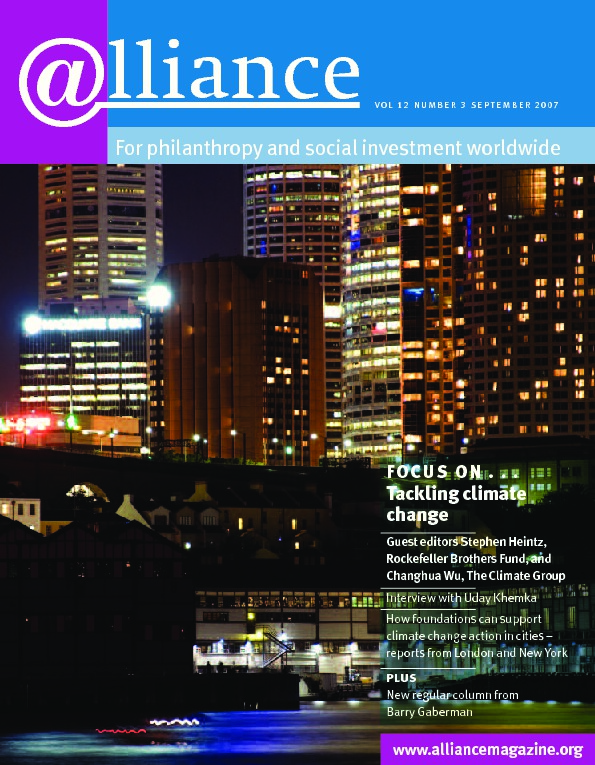Climate change and loss of natural resources and biodiversity are two of the great challenges of the 21st century – yet they are ignored by most established foundations, by the new ‘philanthrocapitalists’, and by government funders alike. It seems that philanthropy’s environmental crisis is as much cultural as financial in that it stems largely from a failure to connect climate change and other environmental issues with what are widely thought of as ‘human’ issues.
‘Please understand, we are not tree huggers,’ said a leading investment banker, as he introduced his firm’s new report on climate change threats to business at a private dinner recently. In the same week, a leading hedge fund manager, commenting on his philanthropy, said, ‘We have a choice. We can help people, or we can help animals.’ At much the same time, the UK government’s Department for International Development (DFID) was lambasted by the Parliamentary Environmental Audit Committee for ‘a complete failure to integrate environmental priorities into UK aid and development policy’.
What is it about the environment that arouses so much confusion and misunderstanding? Why is the mounting concern about the extent and gravity of global environmental challenges not reflected in the funding support for environment charities? These were among the questions that prompted Green Philanthropy: Funding charitable solutions to environmental problems, a new report by New Philanthropy Capital (NPC), based on 18 months of research and over 130 interviews with leading UK, US and European funders, charities and environmental experts.
Inadequate funding of environment charities
We found that less than 2 per cent of the annual grantmaking of the 100 largest UK charitable trusts – £18.1 million out of £1.1 billion – is allocated to environmental causes. The general public’s priorities in the UK are similar: only 5 per cent of private donors give to the environment. These figures are broadly in line with another recent report produced by the UK’s Environmental Funders Network, Where the Green Grants Went 3: Patterns of UK funding for environmental and conservation work.[1]
A recent Stanford Social Innovation Review article[2] shows similar trends in US philanthropy: overall, only 5 per cent of US foundation spending goes to the environment. The article’s author, Charles Conn, also notes that the new wave of ‘philanthrocapitalism’ (or venture philanthropy) has largely eschewed environmental issues. Data for the rest of the world are not available, but it seems likely that trends will follow those in the UK and the US.
In the public sector, the environment budgets of UK and other members of the Organization for Economic Cooperation and Development (OECD) are substantial in the domestic context, but resources for international work – especially in the critical tropical and sub-tropical countries that are most vulnerable to climate change, and also house the most threatened and the most valuable natural assets – are negligible. Just 2 per cent of the UK government’s £2.1 billion aid budget goes to environmental protection.
Why is funding for climate change and other environmental problems so inadequate?
There are various reasons for this. Until recently, difficulties in assembling convincing data on the gravity of environmental problems created uncertainty over the need for action. Poverty and disadvantage are visible now, while environmental degradation is often seen as remote, with consequences to be felt in the future.
This is changing. Landmark reports from the International Panel on Climate Change (2001 and 2007) and the Millennium Ecosystem Assessment (2005) indicate that the scientific community has achieved an unprecedented level of consensus on environmental problems, and is providing the public with comprehensive evidence on the current state of the planet.
Too little information about the charity ‘marketplace’, especially the performance and results of charities, inhibits donors in any sector. NPC has found this to be amplified in the environmental sector. Many donors – including younger philanthropists – want to give to environment charities but are held back by uncertainty over the most effective ways to do so.
What can donors and funders do to help?
More funders are needed. A greater number of funding sources would spread risks as well as increase funding amounts. Charities working on climate change and other environmental problems are currently over-reliant on a handful of charitable trusts. Charities cannot therefore be confident that innovation and ambition will be rewarded by increased support if there is no one to give it.
Show patience and commitment
Solving environmental problems takes time, but funding sources are scarce. New funders may need to fund over the long term, even over ten years, to maximize the impact of their contribution. Support to charitable infrastructure as well as on-the-ground activity will improve the sector’s performance.
Foster collaboration
Current knowledge-sharing and dialogue among funders, and between funders and charities, needs strengthening. Encouragement and funding for well-run networks and forums should help the sharing of knowledge and more collaboration on common goals and agendas.
Be ambitious
There is scope for donors to start new initiatives, and to address some of the gaps in the charitable landscape. In this sector the risk of duplicating existing efforts is low.
Funding priorities
Seed funding
Our research found a particularly urgent need for seed funding. Because climate change is a new problem, solutions are only just beginning to emerge. This puts a high premium on innovation, entrepreneurial energy and ideas. But there is currently a lag between recognition of the challenge and deployment of resources for action. For many new charities and projects, access to funds in the £10,000-£100,000 range will make a very significant difference.
Scaling up and replication
Another requirement is for funding to scale up and replicate proven initiatives. It will take decades to tackle climate change; supporting charities in the early stages is just the first step. Once models and approaches are proven, successful organizations will need help to scale up and replicate. This calls for funders – charitable trusts and foundations that are able to commit to ongoing grantmaking programmes in three- or five-year cycles – to make long-term commitments to address the problem.
Providing better information
The absence of data, evidence and analysis inhibits progress. Even where primary data exists, a lack of energy, confidence and will prevents it from being used to develop good policy guidance. Funders could change this within a few years by supporting charities that collate and analyse results to drive change.
Avoiding mistakes
Perhaps counter-intuitively, avoiding mistakes will be as valuable as producing effective solutions. There is a real danger that tackling climate change will turn into a gold rush, with genuine progress on emissions reduction becoming more and more elusive. The devastation of Indonesian rainforests in order to produce palm oil for biofuels is a current example. The best way of dealing with this is to acquire and disseminate credible evidence on what works and what does not.
Many charities are able to place environmental goals at the top of their agendas, and they are ideally placed to ensure that we do not make disastrous mistakes. But to develop adequate and credible information and analysis, they need adequate funding.
The cultural challenge
There is a need for realism in finding and backing solutions to climate change. We do not know which approaches are going to yield the best results; success is likely to be a function of leadership, creativity and determination rather than any one model. Like any emerging market, winners are hard to pick in advance. This argues for funding strategies that are as open and nimble as possible, discarding preconceived notions about the value of community work versus policy lobbying, or the virtues of public events over closed-door brokering and negotiation.
But perhaps the greatest challenge for climate change philanthropy is the need to understand that environmental problems and human welfare problems are interconnected. In the Horn of Africa, poverty is exacerbated by the deterioration of the natural environment, brought on by deforestation and climate change. When the peatlands of Indonesia are burned, they destroy biodiversity and ‘ecosystem services’ such as freshwater resources, impoverishing the livelihoods of local peoples and releasing vast amounts of carbon dioxide into the atmosphere. Protection of the environment has been constrained in the past by treating the natural world as separate and remote from other social problems. We do not want to repeat these mistakes in the future. Climate change mitigation strategies need to include action to preserve natural resources and biodiversity alongside curbs on emissions from power generation and other outputs from industrial and urban activity.
1 This found that 176 charitable trusts engaged in environment grantmaking provide £33.6 million in funding, or just 1.6 per cent of the £2.04 billion given by 498 of the UK’s largest grantmaking trusts.
2 C Conn, ‘Robbing the Grandchildren: Foundations’ shortsightedness is jeopardizing the planet’s future’, in Stanford Social Innovation Review, Summer 2007.
Bernard Mercer was Founding Chief Executive of New Philanthropy Capital. He is the author of Green Philanthropy. Email bmercer@mercerenvironment.net
For more information
The report will be downloadable from NPC’s website, http://www.philanthropycapital.org from the end of September.



Comments (0)